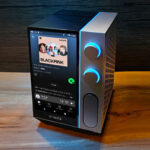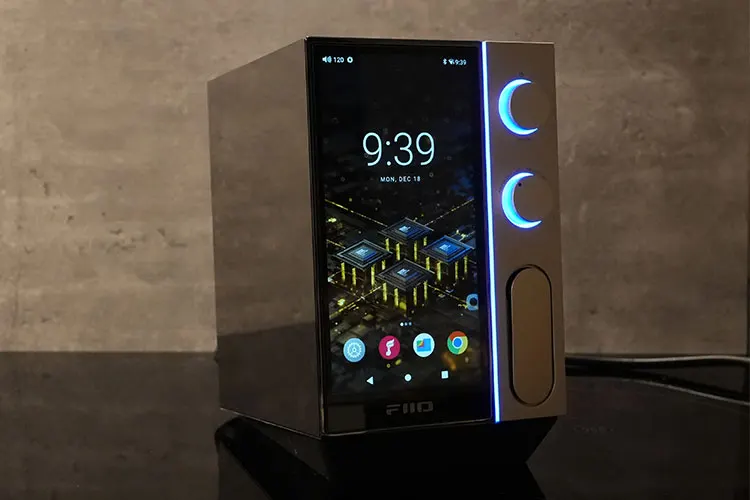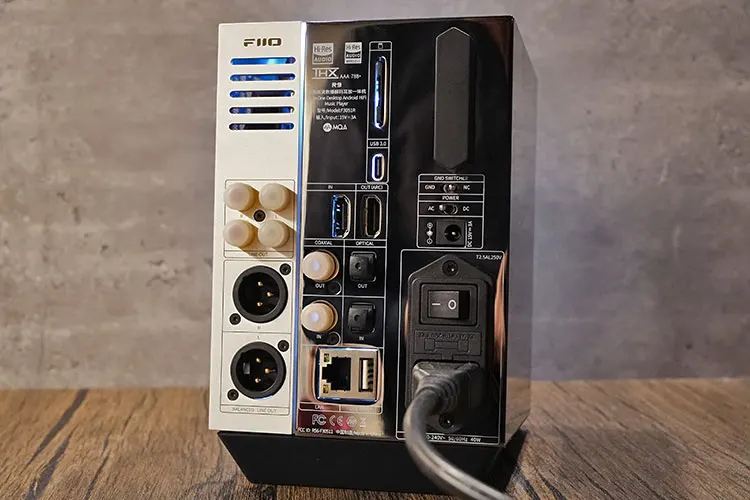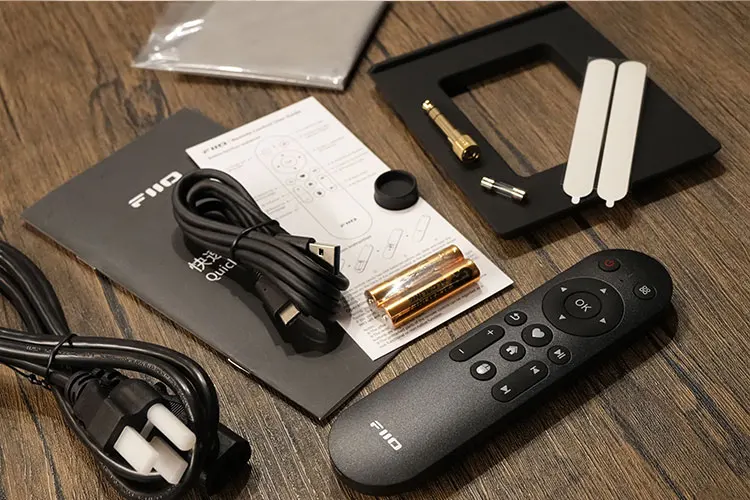In this feature, we review the R9, which is the company’s flagship desktop wireless streamer and integrated DAC, pre-amp, and headphone amplifier. It will be priced at around $1500 SRP when it launches soon.
Disclaimer: This was sent to us as a sample in exchange for our honest opinion. Headfonics is an independent website with no affiliate links or services. We thank FiiO for its support.
You can click here to learn more about the FiiO audio products we have previously assessed on Headfonics.
Note, that this 4-page post follows our current scoring guidelines which you can read in more detail here.
The FiiO R9 is the company’s latest flagship all-in-one desktop streamer, DAC, and headphone amplifier.
It builds on the success of the older R7 with a whole range of upgrades but at the same time keeping that same unique compact form factor with the big LCD screen reminiscent of their larger DAPs.
The R9 is one of the company’s most ambitious releases to date. With a price of around $1500, they are not messing around either.
Does it belong in the top-tier streaming category? We find out in our latest in-depth review here on Headfonics.
Tech Highlights
DAC
FiiO has swapped out the 2-channel ES9068AS on the R7 and replaced it with a dual 8-channel ES9038PRO connected in parallel for a fully differential output.
This is the same flagship chipset on the flagship DAP M17 which should easily enhance the SNR and channel separation when compared to the R7.
At the time we received the testing unit, there was no information on the components around the DAC used but it is likely similar to the R7 adoption of FiiO’s 4th-gen FPGA technology featuring phase-locked loop clock and dual femtosecond crystal oscillators for low-jitter clock signals.
Inside the R9 the new 40W low-noise PSU, DAC, and amplification sections are all on separate boards with metallic shielding, which further avoids crosstalk and enhances the performance. The different sections are connected with Silver-played OFC wires which promotes high-fidelity signal transmission.
USB Decoding
The USB decoding section has been upgraded with the 16-core, XMOS XU316 solution of the XCORE.AI series, featuring fast 2400 MIPS calculation speed and 1024KB RAM, and support handling DOP 256, DSD 512, and PCM 32BIT/768kHz.
This will allow better clocking and jitter control by ensuring cleaner, more stable signal flow in the digital stream.

Streaming
The R9 is preinstalled with a dedicated version of Roon as well as features a market app that allows users to download different supported streaming apps like Tidal and Spotify.
This is a great feature to expose users new to streamers to the best options in the market and to make sure a supported version of the application is downloaded.
Just like with the R7, you can connect the R9 to your 5G Wi-Fi network or via the LAN port with a physical cable that is even more stable.
A new feature on the R9 is the inclusion of a dedicated Bluetooth chipset QCC5125, which supports streaming over LDAC on a Bluetooth connection. With Apple products, FiiO suggests using Airplay receiver mode for the best sound quality.
Amplification
The R9 doubles the amplifier section and has a monstrous, fully balanced, 8-channel module of THX AAA-788+ amplification, connected in parallel via a 2×2 array for a 4-way, fully balanced architecture.
The module is responsible for the amplification duties after the signal goes through the I/V stage, low-pass filters, gain, pre-amp, and current expansion stages.
FiiO emphasized that the OPA2211 op-amps have gone through a silicon-germanium (SiGe) CMOS manufacturing process, including the adoption of ELNA electrolytic capacitors, to contribute to the circuit’s performance. There are also various low-loss metalized film caps and low-noise film resistors being used.
Through FiiO’s 5-level fully connected audio architecture, the R9 outputs as high as 7.3W into 32Ω, doubling the output power of the R7.
This is the most powerful all-in-one streaming device I have seen for this size and allows it to effortlessly drive most headphones. And just like the R7, 5 levels of gain catering for sensitive earphones and planars, or headphones that crave big voltage swings.
Design
The R9 adopts a classic metal bicolor design similar to luxury car finishing. This is a mirror-polished metal section treated with 11 polishing and electroplating steps to create a unique and attractive textured surface.
Combined with accompanying RGB lighting and matte aluminum it results in a breathtaking, artistic appearance. It looks even better in person than in the photos or renderings and is the coolest FiiO product thus far.
Featuring a larger, 6-inch (1080*2160) screen with a significantly improved resolution compared to the R7’s 4.97″ 720p screen, the R9 displays information with better pixel density. This enhances the premium experience when viewing infographics and videos.
You may also notice there are no customizable buttons like on the R7 which makes the front side of the R9 even cleaner.
The tilting angle of the device is perfect for a PC desk setup. However, it’s worth noting that if you are controlling it while standing up, you may need to take a step back or preferably use the remote control.
The RGB will change colors with the bit rate/codec and I really like the TRON-like blue color when I stream via Spotify, also how it leaks through the honey-comb side plates, through which you may observe the internal shieldings over the core components.
I/O
The R9 maintains a sleek profile with the front side featuring a 4-pin XLR balanced headphone output, 4.4mm balanced output, and 6.35mm SE outputs. You can listen to the speakers hooked to the RCA output and phone out simultaneously by switching to “PO + PRE-OUT”.
On the back panel, you’ll find two sets of RCA lineouts, allowing you to connect the R9 to external amplifiers or active speakers.
Additionally, you have the option to use the XLR Balanced Lineout for connecting to studio monitors. Adjacent to the lineouts, there is an SD card slot. FiiO has thoughtfully included a card converter, enabling you to directly plug the card from your DAPs (digital audio players) into the R9.
The R9 offers Optical In/Out and Coaxial In/Out options, providing flexibility for a pre-amp setup or a digital jukebox configuration. FiiO takes it a step further by including a LAN port, allowing you to connect the R9 to your local network.
This enables you to stream videos and music from your NAS (Network Attached Storage) directly to the R9, expanding its functionality and enhancing your media streaming capabilities.
Similar to the R7, the R9 also offers a USB 3.0 and USB A Host port. These ports allow for various connections, such as keyboards, dongles, external monitors, DACs, hard disks, and expansion hubs. This versatility enables you to connect and expand your setup with ease.
One additional feature that is new on the R9 is the HDMI-IN and ARC function. For example, you may put the R9 between your game consoles and sound bar or monitor supporting the HDMI ARC connection and listen to the R9’s RCA or XLR outputs. It is also possible to connect to an external screen via the HDMI OUT function.
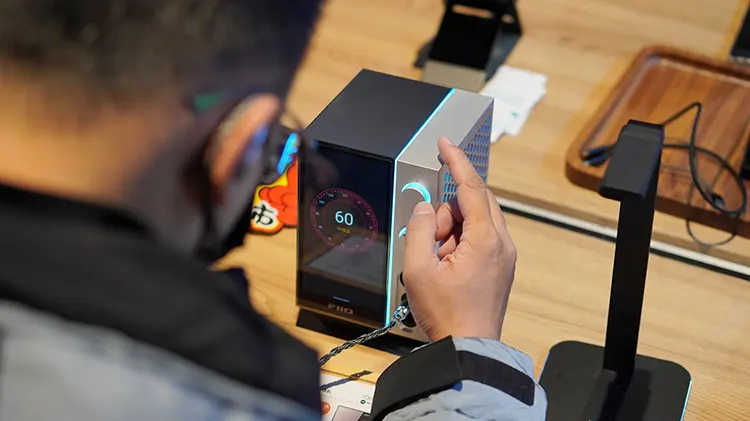
Controls
In comparison to other streamers such as the iFi Audio NEO Stream, the R9 stands out with its larger and higher-resolution screen. Its layout, resembling that of one of FiiO’s larger DAPs such as the M11 Plus ESS or M17, offers a more intuitive user experience.
Switching between different outputs is effortless thanks to the conveniently placed knobs on the front panel, as you can access different inputs and modes by holding the on/off button and changing the output with the knob below.
One practical advantage the R9 has over larger-sized streamers is its user-friendly design. With larger streamers, placing them on the side of a desk often means the screen is not directly facing the user, making navigation more challenging.
The R9, on the other hand, can be easily placed on any part of the desk, ensuring that the screen is facing the user directly, this design consideration enhances usability and convenience.
FiiO has also made changes to its design by removing the customizable touch-sensitive buttons below the screen and incorporating them into the displayed area. This enlargement of the screen size creates an experience that closely resembles using an Android phone.
The inclusion of a remote control also makes the experience even more enjoyable as you can sit back on the sofa and navigate to the next song.
Packaging & Accessories
The R9 comes in a huge cubic box that is well-protected with an outer box. It is more than 2kg in weight, nearly double the R7 so it feels quite heavy. The unboxing is fun and as you tear down the box you will find the below accessories:
- Cleaning cloth
- Extra fuse
- Power cords
- USB cable for data transfer
- Jack cover lids
- Bluetooth remote control
- 3mm to 3.5mm converter
- SD card converter
- Flat/tilted rubber bases
- Securing stickers for the rubber base
It is also worth mentioning that FiiO has pre-applied protective films to the glossy body, so you do not need to be worried about scratching it.
Click on page 2 below for our software impressions and wired/wireless performance measurements.
Click on page 3 below for our sound impressions and recommended pairings.


